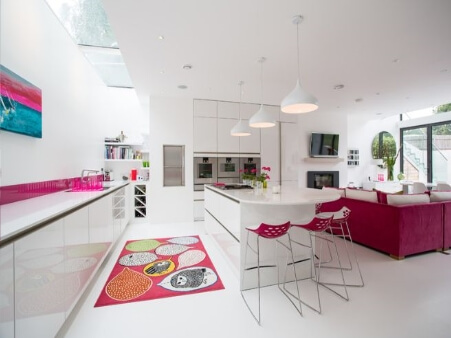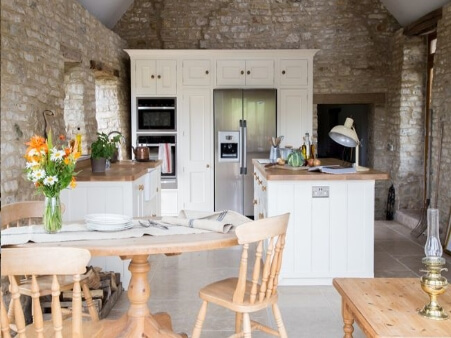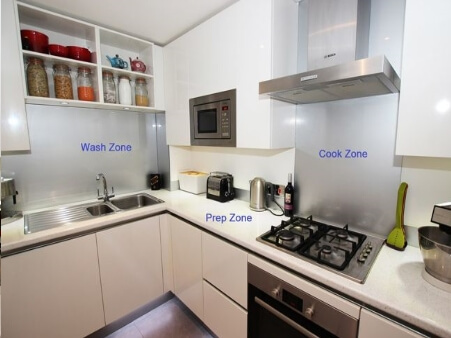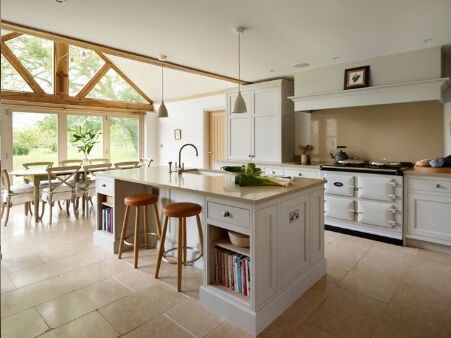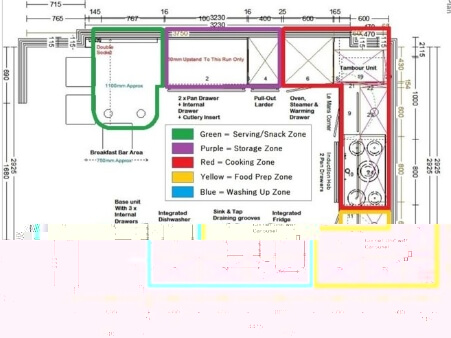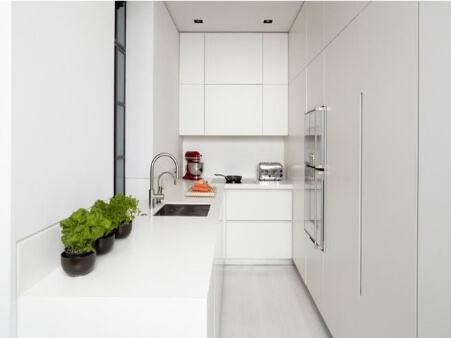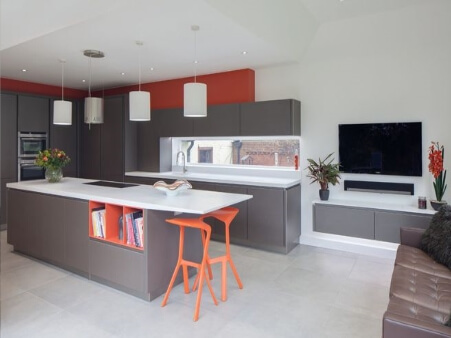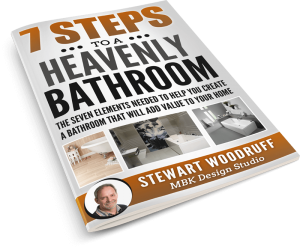Another of our series of Blogs called “Ask the Experts” and this one is by Graeme Wilson a Houzz UK Contributor.
Many designers plan kitchen layouts using the traditional ‘working triangle’ method, with the fridge, hob/oven and sink arranged in a triangle formation. Developed in the 1940s, the kitchen triangle came about as a way to reduce unnecessary steps between appliances and improve kitchen efficiency as a result.
While it can work brilliantly, this classic method also has some limitations – and it doesn’t work for every kitchen. It also assumes there are only three appliances (fridge, hob/oven and sink), whereas most modern kitchens now include multiple appliances. So could it be time to look at an alternative way of zoning your kitchen to achieve your perfect design? Read on to find out more.
What are kitchen zones?
Zones in a kitchen are the separate work sites within a layout, each intended for different tasks and activities. The primary zones are those for preparing food, cooking and washing up.
Depending on your space and preferences, further zones can be set up. These might include areas for serving and eating food, as pictured above, where the eating area is separate from the cooking area, and zones for working or study, or for watching TV. You might even want a separate spot for pets.
The purpose of kitchen zones is to maximise both the space and ease of use, while retaining a good-looking scheme.
What’s in the prep zone?
The kitchen prep zone is really important, as this is where we spend around 70% of our time when using our kitchens. It should include ample work surface for completing everyday tasks, including chopping, peeling, mixing, making a sandwich and more.
Preferably, your storage units and fridge should be in close range of the prep worktop, allowing easy access to ingredients, utensils, pots and pans. Similarly, the kitchen bin should be located within the prep zone, so you can easily dispose of peelings and packaging without having to cross a kitchen and risk messy spills on the floor.
What’s in the cook zone?
The kitchen cook zone typically contains the oven, hob, extractor, warming drawer(s) and any other cooking-related appliances. Ideally, the cook zone should sit adjacent to the prep zone, as pictured, or else opposite it.
You should easily be able to lift newly prepared food into a pan or the oven from your prep work surface. Importantly, this will mean there will be less distance for hot food to travel back to the worktop from the oven or hob – safer both for the cook and other household members, since you won’t have to cross a kitchen while carrying hot food.
Will a cook zone work on an island or in a galley layout?
If the cook zone is opposite the prep zone, such as in a galley or island layout, the oven/hob and sink should be slightly staggered rather than directly opposite each other. This means you turn through fewer degrees between your appliance and sink.
This is not only the most efficient arrangement, it’s also safer; when turning from hob to sink to drain your piping-hot rice or vegetables, this staggering allows a clear line of sight should anyone else enter the kitchen, reducing the likelihood of accidents and burns.
What’s in the wash zone?
The wash zone typically includes your sink, dishwasher and washing machine. Around 20% of our time in the kitchen is spent clearing up after ourselves, yet there’s no fun in this, so it pays to plan an efficient setup, letting you finish up quickly and get back to relaxing.
Ideally, your wash zone should be separated from the prep and cook zone, although having your bin within reach of the sink and dishwasher makes it easy to scrape, rinse and load plates. Similarly, wall cupboards should be at arm’s reach, making unloading a dishwasher full of mugs, plates and glassware an easy task.
If your kitchen design means you’ll avoid traipsing back and forth across the room carrying things, you’ll be done faster. It’s also safer, since there’s less risk of breakages, or someone tripping over an open dishwasher door.
What’s the best way to map out zones and workflow?
During the initial concept stage of planning a kitchen, talk with your kitchen designer about what you want and how you use, or would like to use, your kitchen. They can then assess the space to establish the best layout for achieving this, effecting a smooth flow from one work zone to the next.
Ideally the zones will flow in order of use from: fridge > work space and prep zone > cook zone > serving zone or table > wash zone.
This is evident within the kitchen plan above, where the workflow moves anti-clockwise from prep zone, to cook zone, to serving area, to washing up zone.
Here’s how the finished kitchen looks…
This kitchen was designed for a busy family home with two enthusiastic cooks, who were also keen to retain a clean and tidy kitchen. To facilitate this, and because space permitted, we included an abundance of storage options. This included a full-height corner storage unit by Hacker to maximise otherwise dead space, as well as additional storage along the left-hand wall.
While they had a separate dining room for main meals, the family requested a breakfast bar where they could serve up food and enjoy quick snacks, and where the kids might do their homework.
Finally, it’s worth noting that the fridge is sited clear of the cooking zone. Fridges will often appear on the periphery of a kitchen, as it makes them easily accessible for hungry family members, but without them getting in the way of any cooking while hunting for treats.
What are overlapping zones?
Zone overlapping usually occurs if space is restricted, but this can work just fine as long as there is sufficient workspace for both activities. For example, an overlap of the prep and cook zone is common, consisting of work surface on either side of the hob or oven. This allows separate areas for preparing food as well as landing it after cooking, so the zone overlap doesn’t impede the user.
However, some overlaps of the principle zones should be avoided where possible. This includes an overlap of the prep and wash zones.
Imagine you decide to make dessert following a main course, but your fridge (which is integral to prepping food) infringes on the wash zone. If someone else was still clearing dinner plates, you would certainly be in their way. Equally, someone unloading a dishwasher would be under your feet as you try to whip up that dessert.
This overlap also doesn’t work because dirty dishes easily become lost among those still being used for food preparation.
If this is unavoidable in a small kitchen, then the sink should separate the prep area from the wash zone, as pictured in this compact but well-organised space.
Which workflow rules can be bent?
As with overlapping zones, you don’t have to follow the exact workflow as detailed above, just so long as the format remains close. For example, the fridge could be moved out of the prep zone, and separated from it by the cook zone, as in this kitchen. These zones are similar, so it doesn’t impact the workflow too much.
How flexible can I be?
Essentially, kitchen zoning is based on a designer’s knowledge of aesthetics, usability and efficiency, but the beauty of this approach is that there’s room for flexibility.
Kitchen design and kitchen products have changed significantly since the dawn of the working triangle in the 1940s. More than this, not all kitchen spaces are the same, and neither are users’ needs.
Ultimately, it’s your kitchen and you that has to use it, so when working with a designer, don’t be afraid to ask for changes to the suggested layout and work zones. Modifying the flow can work (and if any requested changes impact too heavily on its success, a good designer will advise you of this). This ensures you can make a fully informed decision to achieve a perfectly personalised kitchen layout.


